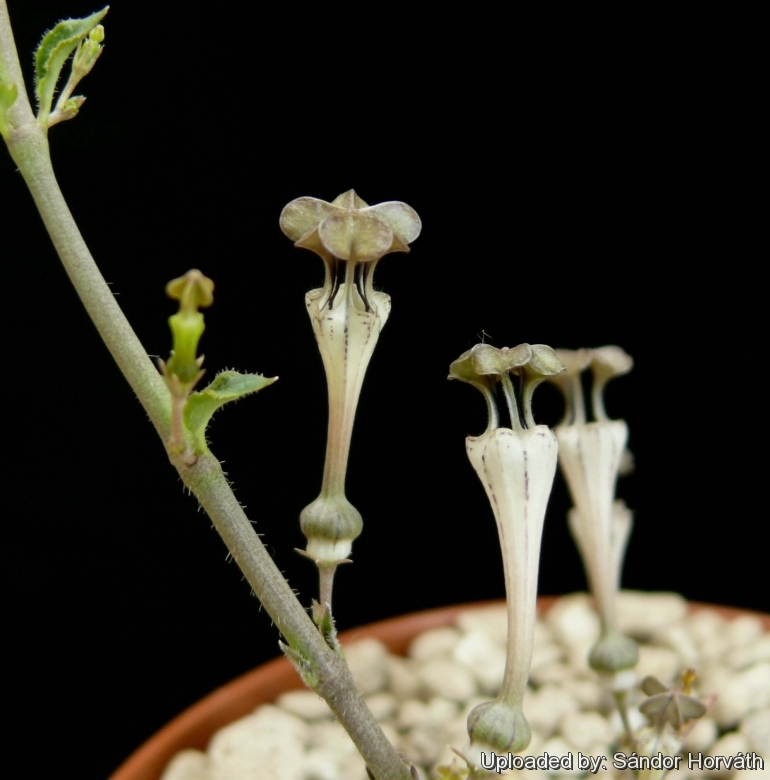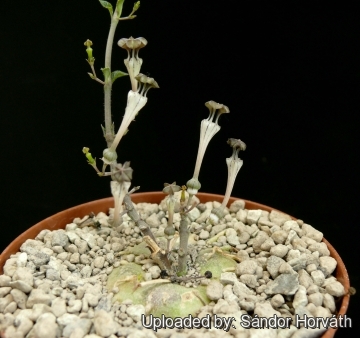




Your support is critical to our success.
- Encyclopedia of SUCCULENTS
- Encyclopedia Index
- Families
- Genera
- Species
- Asclepiadaceae
- Ceropegia
- Caudiciforms
Since 4 Aug 2013

Origin and Habitat: Ceropegia rendalliiSN|32216]]SN|32216]] extends in South Africa from the eastern and northern Transvaal to the northern Orange Free State, Swaziland, Zulu-land, Natal and Transkei; also occurs in Mozambique.
Habitat and ecology: The small tubers are mostly found in loose earth or leafmould in open rocky sites and the twining stems climb into the trees and shrubs. Ceropegia rendalliiSN|32216]]SN|32216]] grows in association with Duvalia politaSN|30450]]SN|30450]] and Brachystelma barbarae.
Synonyms:
- Ceropegia rendallii N.E.Br.
Ceropegia rendallii N.E.Br.
Bull. Misc. Inform. Kew 1894: 106 1894.
Synonymy: 2
- Ceropegia rendallii N.E.Br.
- Ceropegia galpinii Schltr.
Description: Ceropegia rendalliiSN|26496]]SN|32216]] is a slender climber with twining succulent stems arising from a flattened, tuberous rootstock. Flowers are delicate, tubular, greenish, 1-3 in each cluster, about 2-2,5 cm in length and are connate at the tips, where they form a flat, white, green, or purple cage-like structure fringed with hair which, when viewed from the side, gives the impression of an open umbrella. These singular blossoms distinguishes it from other species and yet indicates a relationship with Ceropegia haygarthiiSN|32459]]SN|32459]]. The leaves are fleshy, mostly broadly ovate, but variable in shape and degree of pubescence, usually purple on the undersurface, mottled with mauve or white on the upper surface.
Derivation of specific name: This species was named after after Dr Alfred Barton Rendle (1865-1938), of the British Museum, who sent plants to N.E. Brown at Kew in 1894 .
Tuber (caudex): Flattened 2-7 cm in diameter, sometimes with secondary tubers.
Stems: 1 or 2. annual, twining, to 1 m long or occasionally not more than 5-10 cm high and then erect, slender, terete, 1-2 mm in diameter, glabrous, green, red with age.
Leaves: Opposite, near ground level, diminishing upwardly, somewhat fleshy, glabrous or with a few scattered short hairs on both sides and with or without a short ciliation. Petiole 2-5 mm long. Blade ovate-acute to linear-elongate, 12-25 mm long and 6-12 mm broad when ovate, 25-36 mm long and 25-30 mm broad when linear or linear-oblong, obtuse to short tapering and with a small spiny tip upper face green, lower face grey-green.
Inflorescences. Peduncles 1-3(-5) flowered, Peduncle up to18 mm long (usually shorter), glabrous, bracts subulate. Pedicels 2-6 mm long, glabrous.
Flowers: Long-lived. Sepals 2-3 mm long, subulate, glabrous. Corolla to 18-28 mm long with a 5-lobed base. Corolla-tube 12-18 mm long, lightly curved, base with a globose swelling, expanded towards the mouth as well, 2-3 mm in diameter at the base, contracted to 2 mm in diameter above and dilated to 5-6 mm in diameter at the funnel-shaped mouth, glabrous outside, thinly pilose with long fine hairs within, apparently dark purple at the base, but perhaps only inside, whitish above. Lobes very slender and claw-like-cordate at the erect basal half, inflexed, dilated and all united above into an umbrella-like canopy 8 mm in diameter, raised 5-6 mm above the mouth of the tube, with 10 rounded marginal lobes, which, together with the claws, are shortly ciliate, but the hairs are easily detached, apparently dark purple or green; outer corona 1 mm long, equalling the staminal column, cup-like, apparently 5-angled, truncate or rising into very short deltoid lobes at the angles, glabrous; inner corona-lobes 1 mm long, erect, much overtopping the staminal column, laterally much flattened and about 0.5 mm broad, broadly recurved-falcate, obtuse, dorsally connected at the base to the outer corona and seeming to form part of it, apparently scarcely incumbent on the backs of the anthers, glabrous. The flower is similar to that of Ceropegia sandersoniiSN|32216]]SN|26496]], but smaller.
Blooming season: Flowering time is spring (November-February in habitat)
Fruits: The fruit is a two-horned follicle that is typical for the genus as a whole.
Bibliography: Major references and further lectures
1) Gerrit Germishuizen “Transvaal Wild Flowers” Macmillan South Africa (Publishers), 1982
2) Scott-Shaw, C.R. 1999. “Rare and threatened plants of KwaZulu-Natal and neighbouring regions.” KwaZulu-Natal Nature Conservation Service, Pietermaritzburg.
3) Foden, W. & Potter, L. 2005. “Ceropegia rendallii” N.E.Br. National Assessment: Red List of South African Plants version 2015.1. Accessed on 2016/01/05
4) N. E. Brown “Flora Capensis”, Vol 4, 1909
5) J.P. Roux “Flora of South Africa”, 2003
6) David Hardy, Anita Fabian, Gerrit Germishuizen “Succulents of the Transvaal” Southern Book Publishers, 1992
7) Focke Albers, Ulrich Meve “Illustrated Handbook of Succulent Plants: Asclepiadaceae” Volume 4 Springer, 2002
8) Inez C. Verdoorn, L. E. W. Codd “Wild Flowers of the Transvaal” Trustees, Wild Flowers of The Transvaal Book Fund, 1962
9) Hermann Jacobsen “Abromeitiella to Euphorbia” Blandford Press, 1960
10) J. Smartt, N. Haq “Domestication, Production and Utilization of New Crops” International Centre for Underutilized Crops, Institute of Irrigation and Development Studies, University of Southampton, 1997
11) Aloe 18: 26 1980
12) Robert Allen Dyer “Ceropegia, Brachystelma and Riocreuxia in southern Africa”. VIII, 242 S., Rotterdam, Balkema, 1983
13) Rowley, “Caudicifonn & pachycaul succulents” 34, 77, 1987
14) "Flora of southern Africa" 27(4): 68, 1980
15) James Cullen, Sabina G. Knees, H. Suzanne Cubey “The European Garden Flora Flowering Plants: A Manual for the Identification of Plants Cultivated in Europe, Both Out-of-Doors and Under Glass” Cambridge University Press, 11 August 2011

Ceropegia rendallii Photo by: Sándor Horváth
The gallery now contains thousands of pictures, however it is possible to do even more. We are, of course, seeking photos of species not yet shown in the gallery but not only that, we are also looking for better pictures than those already present. Read More...
Cultivation and Propagation: Ceropegia rendalliiSN|22143]]SN|32216]] belongs to the complex of Ceropegia africana, Ceropegia multiflora and Ceropegia linearisSN|32216]]SN|22143]], and is as easily cultivated and rewarding as the latter. In cultivation, it is one of the easiest in the genus to grow. The caudex should be buried to protect it from full sun.
Soil: Use a very draining mineral potting substrate.
Repotting: This plant needs plenty of space for its roots, repotting should be done every other year or when the it has outgrown its pot. Use pot with good drainage.
Watering: It needs regular watering, especially during the hottest summer days. During winter dormancy, the plant should be kept completely dry however provide some light watering if the green house temperatures in winter are elevated. Either excessive or very scarce watering can induce rot.
Fertilization: Feed with a high potassium fertilizer in summer.
Frost Tolerance: Need frost protection. Recommended minimum temperature is 12 °C or even above.
Sun Exposure: Light shade.
Traditional uses: The roots are eaten roasted by the Botswana.
Propagation: Seeds. Plants can also be propagated from cuttings.
| Your Actions | |
|---|---|
| Back to Ceropegia index | |
| Back to Asclepiadaceae index | |
 |
Back to Succulents Encyclopedia index |
Privacy stantement - Terms and conditions - How to cite - About us - Feedback - Donate




